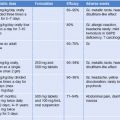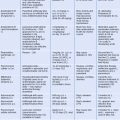CHAPTER 17 Diseases with Long Latency Periods
Initial Screening
Table 17.1 Common opportunities for the identification of latent infections among immigrants
Tuberculosis
Latent tuberculosis infection (LTBI) is commonly identified. Current World Health Organization (WHO) estimates indicate that one-third of the world’s population is infected with tuberculosis, with the incidence increasing by 1% every year; the incidence is 44% in Southeast Asia, 35% in Africa and the Western Pacific, 29% in the Eastern Mediterranean, 18% in the Americas, and 15% in Europe.1 An individual with a positive tuberculin skin test (TST), i.e. PPD, should always have chest radiographs performed to exclude abnormalities suspicious for active pulmonary TB. In persons with LTBI, the standard recommendation is 9 months of isoniazid therapy. One large caveat exists. Should immunosuppression with corticosteroids or anti-TNF-alpha medications be anticipated in the near future, a more aggressive LTBI treatment regimen may be appropriate.2 Anti-TNF-alpha antagonists, such as infliximab and etanercept, are associated with a 15- and 50-fold higher incidence of active TB, respectively.3–5 Time of onset of an opportunistic infection varies by TNF antagonist, but 50% of TB cases will appear within 90 days of initiation of infliximab and within 1 year for etanercept.5 Ideally, LTBI therapy should be started for 2 months prior to immunosuppression.
Syphilis
Another common occurrence is a positive VDRL or RPR syphilis screen in asymptomatic immigrants. In one study of 750 Ethiopian immigrants, 12% of adults had positive treponemal tests without clinical disease or neurologic deficit.6 In rural Gambia, 17% of asymptomatic persons were VDRL seropositive.7 It is unclear whether such scenarios represent an unusual natural history of infection, cross-reaction to yaws or with other treponemal diseases, partial treatment, or false positives. Indiscriminate antibiotic usage could cause syphilis or yaws to remain subclinical yet not eradicated.7 Yaws can relapse with ulcerative skin lesions as long as 5–10 years after initial infection or with tertiary manifestations with bone, joint, or soft tissue deformities occurring. Neurologic abnormalities do not occur with yaws. Examination of cerebrospinal fluid (CSF) among VDRL-positive Ethiopian and Thai immigrants has been shown to be of low yield.6,8 Thus, among HIV-negative individuals, an individual with a positive low-titer VDRL and who has no neurologic symptoms can be treated for possible latent infection safely without CSF examination. Treatment consists of a series of 3-weekly penicillin G benzathine intramuscular injections of 2.4 million units or alternatively, in patients who are penicillin allergic and not pregnant, doxycycline 100 mg orally twice daily for 28 days.6 Tetracyclines cannot be used to treat neurosyphilis. A confirmatory treponemal-specific test, such as TP-PA, FTA-AS, should be performed. Follow-up VDRL or RPR at 6 months should demonstrate a fourfold decline in the titer; specific treponemal tests remain positive for life.
Schistosomiasis
Chronic urinary schistosomiasis (5.hematobium) has been associated with squamous cell carcinoma of the bladder, obstruction of the ureters, and renal failure. In additions, ova swept into the verous system can go to virtually any organ in the body, with a predilection for the CNS.
Visceral leishmaniasis
Visceral leishmaniasis (VL) may have a chronic, insidious course with fever, malaise, night sweats, and weight loss with the eventual development of hepatosplenomegaly, pancytopenia, and elevated total IgG. Approximately 500 000 visceral infections occur annually, with 90% in the five countries of Sudan, Bangladesh, Brazil, India, and Nepal.9 Hepatosplenomegaly and emigration from a highprevalence country should prompt diagnostic evaluation. Although splenic aspirate is the gold standard and classic technique for diagnosis in the developing world, other diagnostic evaluation is available to the clinician in the developed world. All patients with VL will have a positive IgG serology. If negative, the diagnosis of VL can be eliminated from the differential. Bone marrow biopsy should be performed on those with a clinical presentation and positive serology. A reference laboratory familiar with VL should be contacted prior to biopsy to secure appropriate culture media and assure collection of adequate samples.
Malaria
Another frequent cause of splenomegaly is hyperreactive malarial splenomegaly that results from an aberrant immunological response to malaria with high antimalarial antibodies and high serum IgM content. In non-malaria regions, diagnosis can be made by elimination of other diagnosis (i.e. visceral leishmaniasis and schistosomiasis) demonstrating elevated malaria antibodies and elevated immunoglobulins, particularly malaria specific IgM. Treatment results in decrease of the malaria specific antibody. Splenomegaly may remain.10 This is perhaps one of few occasions when malaria serology may be helpful. A geographic context is important as in regions also with leishmaniasis, malaria serologies may be equivocal for diagnostic purposes.11,12 Splenomegaly may be present, coupled with chronic malaria infection years after immigration.13
Incidental Laboratory Testing
Immigrants receive primary health examinations from a variety of healthcare professionals, where a spectrum of knowledge of latent infections may be encountered. One of the most commonly encountered incidental findings (Table 17.2) is eosinophilia. Frequently, when concern arises regarding the possibility of latent parasitic infections, three stool ova and parasite examinations are repeated if geohelminths are considered. While repeat stool O&P testing may discover a difficult-to-diagnosis helminth, such as Strongyloides, typically blind testing is low yield, unless a specific clue is present. Often, laboratory clues may be inadvertent or incidental in nature and testing will need to go beyond just stool O&Ps.
Table 17.2 Incidental laboratory abnormalities
| Laboratory abnormality | Clues to diagnosis |
|---|---|
| Eosinophilia >450 cells/mm3 | |
| Alkaline phosphatase, bilirubin elevation | |
| Anemia, microcytic | |
| Anemia, megaloblastic | |
| AST, ALT elevation |
General knowledge of US physicians in training about helminths, and appreciation of the level of eosinophilia considered abnormal is poor compared to international trainees.14 Eosinophilia is considered to be an absolute count >450 cells/mm3. An absolute differential count is more specific than using a relative 5% of the differential.14 Although there may be other etiologies for an asymptomatic eosinophilia such as ectopic disease, eosinophilia in this population overwhelmingly marks an undiagnosed parasitic infection. In a study of Australian immigrants, the presence of eosinophilia had a positive predictive value of > 75% for an intestinal parasite even years after immigration.15 Depending on the region of immigration, common parasites with a very long lifespan include Strongyloides and Schistosoma, with which eosinophilia is present in ≈85% and ≈60%, respectively.14,16 Chronic filarial infections typically also will be accompanied by eosinophilia. With eosinophilia, three stool O&Ps are warranted although these are frequently negative with parasitic diseases with long latency periods; therefore, serologic testing and other diagnostic maneuvers are frequently necessary (see eosinophilia in Ch. 21).
Rarer trematodes, such as Fasciola hepatica (sheep liver fluke) can develop relatively asymptomatic, chronic infections which may be accompanied by eosinophilia (46–92%) and mild elevations in alkaline phosphatase (46%) and gamma glutamyl transpeptidase (GGT) with normal transaminases (ALT and AST).17–19 These chronic Fasciola infections, as well as the biliary liver flukes Opisthorchis and Clonorchis, may present later with obstructive biliary fascioliasis, accompanied by acute onset of jaundice that may clinically be confused with cholelithiasis, cholangitis, or pancreatitis.20,21,22 Fasciola hepatica is endemic worldwide in regions where sheep, cattle, or goats are raised and is associated with consumption of uncooked watercress or alfalfa juice.23 Heavy burdens of infection may cause a normocytic normochromic anemia in children.24
Cestodes, such as Diphyllobothrium latum, the fish tapeworm, are known to be associated with megaloblastic anemia. Their overall incidence is quite rare, as is anemia (<2%), but 40% may have a low vitamin B12 level due to competition for B12 by the tapeworm.25 Generally, this parasite is either detected in the stool O&P examination or when the patient asymptomatically passes the parasite which may be many feet in length. Chronic diarrhea, malabsorption, and small bowel overgrowth are more common causes of vitamin B12 deficiency.26
Amoebiasis continues to be diagnosed in the United States, primarily among Hispanic and Asian male immigrants who typically present with fever and right-upper quadrant pain.27 Amoebic liver abscess may be incidentally diagnosed by an abdominal ultrasound in the evaluation of suspected cholangitis. The diagnosis is confirmed by a characteristic liver abscess by ultrasound accompanied by positive IgG serology. Entamoeba histolytica IgG serology will be positive in 95% when performed after 7 days of symptoms.28 There is no available IgM serology. The latency period is relatively short, with amoebic liver abscesses typically presenting within 3 months and all within 6 months of immigration or returning travel.29
Reactivation of Latent Infections
Tuberculosis
In immigrants with latent TB infection, the lifetime risk of reactivation is highest within the first year, with approximately half the cases in this population occurring within 2 years of relocation.30 However, the risk of pulmonary tuberculosis remains elevated for at least the first 10 years after immigration.31 Approximately half the TB in the immigrant population presents as extrapulmonary TB. It is unclear whether this increased risk is due to intrinsic reactivation influenced by stress, dietary changes/deficiencies (e.g. vitamin D deficiency) or due to transmission within immigrant communities post-immigration. Genotypic relationship data of TB cases from Norway suggest the majority of pulmonary TB is due to reactivation.32 However, national screening and treatment policies for LTBI may influence the relative amount of transmission within immigrant communities. In the US, LTBI therapy is recommended for all individuals unless there is a specific contraindication. Age is no longer considered a contraindication.
Mycobacterium bovis is an infection classically of cattle occurring in developing countries. M. bovis is part of the M. tuberculosis complex and can be mistaken for pyrazinamide-resistant TB in laboratory testing. Mycobacterium bovis should be suspected when there is isolated pyrazinamide resistance and further speciation should be performed. Exposure occurs either by consumption of unpasteurized dairy products or close contact with livestock due to occupation.33,34,37 In the US, M. bovis predominantly occurs among Mexican immigrants (80%) due to immigration patterns, but livestock worldwide can be infected with M. bovis.35 In a study of Mexican meat-processing plants, 17% of cattle sampled were infected with M. bovis and a recent outbreak occurred in New York from imported, unpasteurized Mexican cheese.36 Of M. bovis infections 50–60% are extrapulmonary, and infection may occur in the US-born children of immigrants.33,35,37
Stay updated, free articles. Join our Telegram channel

Full access? Get Clinical Tree







